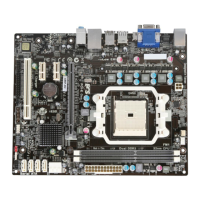
Do you have a question about the ECS A55F-M2 and is the answer not in the manual?
| Brand | ECS |
|---|---|
| Model | A55F-M2 |
| Category | Motherboard |
| Language | English |
Provides a basic overview of the motherboard and its target market.
Details technical specifications of the motherboard's components.
Highlights key features like processor, chipset, memory, audio, and LAN.
Describes PCI and PCI Express slots for add-on cards.
Lists and explains the rear panel ports and connectors.
Overview of the system BIOS and its configurable features.
Visual identification of key motherboard components.
Crucial guidelines to prevent damage during installation.
Advice on selecting a compatible and suitable computer case.
Step-by-step instructions for physically mounting the motherboard.
Explains how to correctly set motherboard jumpers for configuration.
General guidance on installing hardware components.
Detailed procedure for installing the CPU onto the motherboard.
Step-by-step guide for CPU installation and cooler attachment.
Instructions for installing DDR3 SDRAM modules.
Detailed steps for inserting memory modules into DIMM slots.
Information on PCI and PCI Express slots for add-on cards.
Guide to connecting SATA, USB, COM, and LPT headers.
Instructions for installing SATA hard drives and cables.
Connecting external peripherals to rear I/O ports.
Connecting internal case switches, LEDs, and fans to motherboard.
Overview of the BIOS Setup Utility and its configuration capabilities.
Procedure for resetting BIOS settings to factory defaults.
Lists keyboard shortcuts for navigating the BIOS interface.
Explains the primary BIOS screen and system information.
Contains settings for CPU, power management, and other system options.
BIOS settings for the onboard LAN controller.
Monitors system voltages, temperatures, and fan speeds.
Configures system power saving features and wake-up events.
Settings for ACPI sleep states and power management.
Detailed settings related to the CPU, including clock speed and cache.
BIOS settings for the Serial ATA controller and ports.
Settings for enabling/disabling USB devices and legacy support.
Configuration for serial and parallel ports.
Settings for North and South Bridge chipsets.
BIOS section for adjusting CPU ratio and memory timings.
Configures boot device order and NumLock state.
Sets administrator and user passwords for BIOS access.
Options to save changes, exit, or reset BIOS settings.
Procedure for downloading and installing new BIOS versions.
Introduction to the included software and drivers.
Guide to using the CD/DVD auto-install feature.
Steps for manually installing drivers from the disk.
Information on available utility software and their terms.
Explains AMD CrossFire for enhanced graphics performance.
Lists compatible discrete GPUs and APUs for Dual Graphics.
Advice on optimal hardware configurations for CrossFire.
Configuring BIOS SATA settings for RAID.
Setting up RAID array types and drives within BIOS.
Procedure for installing AMD RAID drivers during OS setup.
Addresses common issues encountered during initial PC assembly.
Solutions for startup issues that may arise after extended use.
Provides advice for proper care and upkeep of the motherboard.
A visual guide to diagnose and resolve common PC problems.
